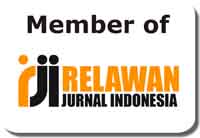Riak in Dayak Maanyan Ritual Tradition (An Ethnolinguistics Study)
Abstract
Keywords
Full Text:
PDFReferences
Arini, D. N. (2016). Politeness Distinction: Terms Of Address Used By Banjerese Youth In Daily Life. Langkawi, 2(2), 233--248.
Blust, R. (2015). The Austronesian Languages (Revised Ed). Canberra: Asia-Pacific Linguistics Research School of Pacific and Asian Studies The Australian National University.
Copland, F., & Creese, A. (2015). Linguistic Ethnography. London: Sage Publications.
Crystal, D. (2008). A Dictionary of Linguistics and Phonetics (6th ed.). Oxford: Blackwell Publishing.
Duranti, A. (1997). Linguistics Anthropology. Cambridge: Cambridge University Press.
Eberhard, D. M., Simons, G. F., & Fennig, C. D. (2019). Ethnologue: Languages of the World. Twenty-second edition. Dallas, Texas: SIL International. Retrieved from http://www.ethnologue.com
Foley, W. A. (2016). Anthropological Linguistics and Field Linguistics. In K. Allan (Ed.), The Routledge Handbook of Linguistics (pp. 250–263). London and New York: Routledge, Taylor and Francis Group.
Fox, J. J. (2014). Explorations in Semantic Parallelism. Canberra: ANU Press.
Herrmans, I. (2015). Rituals Retellings, Luangan Healing Performances through Practice. New York, Oxford: Berghahn.
Herrmans, I. (2017). Values in Practice: Change and Continuity in Luangan Ritual Performance. In C. Arenz, M. Haug, S. Seitz, & O. Venz (Eds.), Continuity under Change in Dayak Societies (Sozioökono, pp. 191–214). Wiesbaden: Springer VS.
https://doi.org/10.1007/978-3-658-18295-3
Kridalaksana, H. (2008). Kamus Linguistik Edisi Keempat. Jakarta: Gramedia Pustaka Utama.
Mage, A. M. (2014). Semantic Analysis of Ethnopoetics of Pangunraun In Mariage Negotiations of Maanyan Dayak of Central Kalimantan. The Multifaceted Dimensions of English Linguistics, Literature, and Education, 343–363.
Rais, W. A. (2017). Kearifan Lokal dalam Bahasa dan Budaya Jawa: Studi Kasus Masyarakat Nelayan di Pesisir Selatan Kebumen Jawa Tengah (Kajian Etnolinguistik). Surakarta: UNS Press.
Riswara, Y. (2012). Puitika alam Lirik Saluang: Sebuah Kajian Etnolinguistik Minangkabau. Madah, 3(2), 113–121.
Rodrıguez, L., & Lopez, S. D. (2019). Performing Healing: Repetition, Frequency, and Meaning Response in a Chol Maya Ritual. Anthropology of Consciousness, 30(1), 42–63. https://doi.org/10.1111/anoc.12107
Saville-Troike, M. (2003). The Ethnography of Communication: An Introduction (3rd Ed.). Malden; Oxford; Melbourne: Blackwell Publishing Ltd.
Sharifian, F. (2014). The Routledge Handbook of Language and Culture. New York, NY: Routledge.
Soriente, A., & Inagaki, K. (2012). Kalimantan languages: An overview of current research and documentation. In Current Trends of Linguistic Research of Indigenous Languages in Indonesia. Retrieved from https://lingdy.aa-ken.jp/wp-content/uploads/2012/01/120217_soriente_inagaki_h2.pdf
Sumadi, Septiana, D., & Yuliadi. (2015). Bahasa Maanyan, Lawangan, Bakumpai, Paku: Sebuah Penelitian Kekerabatan Bahasa di Kabupaten Barito Timur, Kalimantan Tengah. Yogyakarta: Lokus.
Ukur, F. (1971). Tantang-Djawab Suku Dayak: Suatu Penyelidikan tentang Unsur-unsur yang Menyekitari Penolakan dan Penerimaan Injil di Kalangan Suku Dayak dalam Rangka Sejarah Gereja di Kalimantan 1835-1945. Jakarta: BPK Gunung Mulia.
Wardhaugh, R., & Fuller, J. M. (2015). An Introduction to Sociolinguistics (7th ed.). Malden; Oxford; West Sussex: Wiley Blackwell.
Wheelock, W. T. (1982). The Problem of Ritual Language: From Information to Situation. Journal of the American Academy of Religion, 50(1), 49–71. Retrieved from http://www.jstor.org/stable/1462155 .
DOI: http://dx.doi.org/10.31332/lkw.v5i2.1378
Copyright (c) 2019 Dwiani Septiana, Riyadi Santosa, Sumarlam Sumarlam

This work is licensed under a Creative Commons Attribution-ShareAlike 4.0 International License.
Langkawi: Journal of The Association for Arabic and English indexed by:


















.png)
.png)

.png)
2.png)








